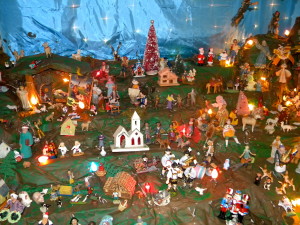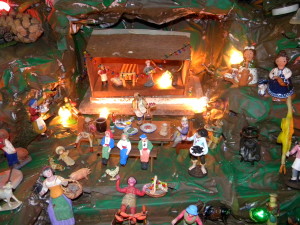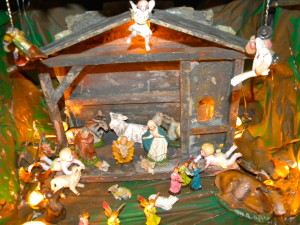The Christmas season is a time known for its traditions, from putting up lights and stockings, to singing carols and of course displaying a Christmas tree.
But there’s a tradition that lives on today that has been passed on from generation to generation: the construction of a presepio, a Nativity scene depicting the birth of Jesus.
A Nativity scene features a manger, angels, shepherds and Magi; however, a presepio often includes the Nativity scene surrounded by statues and houses representing everyday life. The symbolism is that Christ was born into the real world and lived among everyday people.

The tradition started in Italy in the 13th century when St. Francis of Assisi created a living Nativity in the town of Greccio for the Christmas midnight Mass in the year 1223. Inside a cave, he prepared a manger with animals and celebrated Mass. There were even claims of miraculous healings following the building of this crèche.
From these early roots, the tradition began to spread throughout all of Italy. Presepi (in plural form) were mostly built in churches during the weeks leading up to Christmas. Soon, wealthy citizens commissioned the building of presepi in their own homes. Even poorer people built presepi by using whatever materials they had.
Presepi were modeled after the local villages where the builders lived. By the 17th century, erecting a presepio during the Christmas season – popularized by St. Gaetano who encouraged people to build a crèche as a sign of devotion – became commonplace in nearly every Italian home.
Here in the Diocese of Brooklyn, the tradition of presepi came across the Atlantic Ocean with the Italian immigrants. While the traditional elements have remained the same, each presepio adds its own individualistic qualities representing the imagination of its creator.
Each year, Bishop Nicholas DiMarzio enjoys the presepio set up in the lobby of the diocesan Chancery building in Park Slope. St. Helen’s parish, Howard Beach, has also continued the tradition over the years.
At St. Athanasius parish, Bensonhurst, the presepio has been a tradition for over 40 years. Its builder, parishioner Antonio Vigilante, emigrated from Italy and began constructing the scene with 10 to 15 statues.
However, the scene grew each year to the point where it had to be permanently moved to the lower church. It is displayed from the start of Advent through Little Christmas (Feast of the Epiphany) and is covered by a curtain for the remainder of the year. The original manger scene has remained in tact, but the statues have evolved to reflect the changing population of the neighborhood.
“The symbolism is that all the world comes to see the baby Jesus,” said Msgr. David Cassato, pastor at St. Athanasius. “It shows the shepherds and kings around the baby, but it also shows the townsfolk around the baby Jesus. Some are in more modern attire. It’s really a work of art.”
One Family’s Tradition
In the Dec. 25, 1982 issue of The Tablet, reporter and youth editor Francis DeBernardo, a former parishioner at Immaculate Heart of Mary, Windsor Terrace, wrote an article – “Miniature Villages House the Spirit of Christmas” – on the history of presepi and how the tradition was practiced in the Brooklyn Diocese. DeBernardo’s interest was sparked by his family’s building of a presepio each Christmas in the family’s home on 12th Avenue in Kensington.
 DeBernardo’s family on his mother’s side, the Grillo’s, traces its origins to Torre del Greco, a small town outside Naples, Italy. The family immigrated to the States in 1924 and moved into the 12th Avenue house in 1934.
DeBernardo’s family on his mother’s side, the Grillo’s, traces its origins to Torre del Greco, a small town outside Naples, Italy. The family immigrated to the States in 1924 and moved into the 12th Avenue house in 1934.
DeBernardo remembers his grandfather Louis “Luigi” Grillo constructing a presepio on a flat board with just a few statues, houses and one string of lights. However, when Grillo was younger, he would build an elaborate presepio using boxes and paper mache to simulate the Italian countryside of his birth.
In researching his story by visiting the various presepi in Brooklyn and Queens and seeing old photos of his family’s original version, DeBernardo decided to build his very own presepio for Christmas, 1982. His mother Celia helped with the techniques, and his father Jim helped with the actual building.
 Since then, the presepio in the DeBernardo household has been an annual tradition. The building process commences every Thanksgiving weekend and usually takes about three to four days to complete.
Since then, the presepio in the DeBernardo household has been an annual tradition. The building process commences every Thanksgiving weekend and usually takes about three to four days to complete.
The first step is stringing up lights and a blue curtain in the basement to serve as the night sky. Tables and boxes are then brought in from the garage and arranged to form the framework of the presepio. Next, the paper mache – created with newspapers and a secret family substance known as “goop” – is laid down, forming caves and jagged edges to simulate the topography of Bethlehem.
“I love that the whole thing is primarily made from simple items,” DeBernardo said. “Presepio-making is really a folk art, not a fine art, so it is made with very homespun sort of materials. Jesus was born in a simple setting, so I think it’s appropriate that the presepio is made from simple materials.”
The structure dries on Thanksgiving Day, and the next few days are used for painting, stringing the colored lights and arranging the statues and houses. Many DeBernardo family members pitch in to help.
The family’s presepio is built in the Neapolitan style, since Luigi Grillo was from Naples. All Neapolitan presepi include the manger scene, a restaurant scene and sleeping shepherds. Other styles are Sicilian, which includes sea materials such as coral and mother of pearl, and Roman, featuring materials from pine and olive trees.
Since 1982, the DeBernardo presepio has evolved drastically. The scene now includes a working stream that empties into a lake powered by a water pump, and the entire display has more than doubled in size.
Even with the increase in size, every square inch of the presepio is still covered with statues. All of the original statues came over with the family from Italy, but DeBernardo has collected a wide variety of statues over the years from his global travels, with nearly 30 countries represented.
“I love Christmas very much,” DeBernardo said. “I think that building a village with statues of all sorts of people doing all sorts of activities is a powerful way to get the message out that Christ was born for all of humanity, in all of its wonderful diversity.”

Jim,
My mother, following the tradition brought over from Reggio Calabria by my grandfather when he was a little boy, also built a presipio every year from the time she was married in 1943 until she died in 2007. Actually, it had grown so much that they built a special house in which it took up the atrium, the stairway and a special room upstairs, but Francis’ pictures and story strongly remind me of it — including the preparation of “goop.” In the final years, we would have up to 600 visitors a year, many of them third generation visitors, and it was featured many times on local TV stations and in the newspaper. Mom would take groups of 10 -40 at a time through the story of Christmas starting with August Caesar’s proclamation through the birth of Our Lord, and then through story after story about modern Christmas activities illustrated with animated sleds and skiers, electric trains and cars, a bunch of animated singing dolls and Santa Claus scenes, the Nutcracker Ballet, and end it with the story of the Littlest Angel, which ends, as you know, back at the Crib.
Grandpa called it a Christmas Garden, because he knew no English equivalent of what he remembered from the Old Country; he came over when he was eight years old and he saw a “Christmas Train Garden” that the local fire stations used to put up for the kids in Baltimore. So what we later found out was called a presipio in Italy, became our Christmas Garden, and yes, complete with my electric train set.
We brought mom home from the hospital, when the inevitable became obvious, to pass away near her beloved Christmas Garden, and showed it for her for a number of years until Dad passed, but eventually we had to sell the house. I inherited the two trailer loads of pieces, including the diorama of the story of the Littlest Angel that hung from the ceiling and the tape of my mother telling the story to all the little children sitting in their parents’ laps. I will put it up, but slightly differently, as soon as I can get fully moved into our new house. We have 40 minute DVD of it. Would like to share experiences with the DeBernardos if they wish. If so please pass them my email. Thanks, Al Dumas, Bossier City, Louisiana